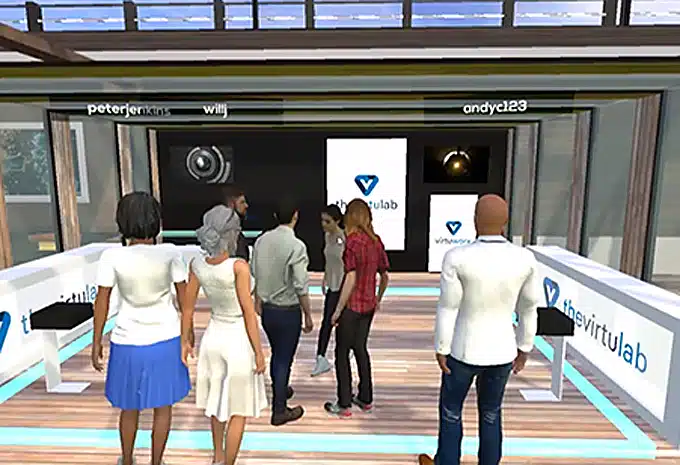Over the last year many of us have grown accustomed to the remote way of life. Balancing video conference calls with homeschooling the kids. Delivery drivers are becoming our defacto grocers and pharmacists, delivering all we need to our doors. In some countries, delivery drivers are even bank tellers, equipped with ID and fingerprint scanners, performing KYC procedures at our front door.

While the shift to at-home deliveries was happening well before the pandemic, the work from home trend skyrocketed in 2020, with research from Finder stating that at the height of the lockdown, 60 percent of the UK’s adult population were working from home, and 26 percent saying they intended to continue working from home in some capacity even after the pandemic. So, the question now is will work in the future include never actually having to leave your front door?
In a February 2021 analysis by McKinsey, 2,000 tasks used in 800 occupations in eight focus countries were looked at to determine how extensively remote work will be utilised after the pandemic. Focussing on tasks that can be completed remotely without affecting productivity, they found that 20 to 25 percent of workforces, in advanced economies, could work from home between three and five days a week.

The McKinsey findings also support the move of many big businesses currently trying to unload large blocks of office space, including major firms like JP Morgan Chase & Co, Salesforce and PricewaterhouseCoopers. According to CBRE Group Inc, by the end of 2020, 137 million square feet of office space was available for sublease across the United States. This represents a staggering 40 percent increase from the previous year, and the highest figure since 2003.
As everything points to remote work continuing in some capacity for the foreseeable future, the question now becomes how can we make the experience not only more productive, but also more enjoyable? Standard tools such as Zoom, Microsoft Teams and Google Meet have been crucial to helping businesses ride out the last 12 months, but they are essentially just an iteration of the same technology that has been around for decades. How many of us have experienced Zoom fatigue after back-to-back meetings on the platform throughout the workday? They’re great for short interactions and check-ins, but they leave little to be desired in terms of creating an interesting and inspiring work environment.
The jobs of today are increasingly digital and Software As A Service Platforms are revolutionising admin systems, meaning value is being created by fewer people than ever before. In the old days, an employee’s worth was very much determined by their time spent in the office, or on a particular task. As the paradigm shifts, value is being redefined as teams look for ways to ensure a work/life balance is achievable, especially when operating remotely.
Digital technology companies specialising in virtual and augmented reality are gaining traction. Targeting industries and markets that before would have seen their technology as a fun but largely unusable resource. From events, to meaningful collaborations and remote management and tracking, digital technologies look set to have a real impact in how we will work in the future.
“The pandemic gave companies an opportunity to really embrace a remote workforce,” explains Executive Director of The Virtulab, David Cummins.
The UK-based firm is at the forefront of this trende and is using their proprietary Virtuworx platform to help businesses transform work from home options as well as live events. The digital skunkworks of the CG Tech Group, The Virtulab team has been used to recognise challenges and create solutions across CG Tech’s investment portfolio.
“Over the years it’s worked both ways,” explains The Virtulab’s Chief Technology Officer Wayne Strydom. “We’d either be approached with a problem, or we would approach the group with a compelling technology and examine ways to use it to their advantage.”
This included coming up with a digital training solution used by oil and gas engineers. Giving them a virtual environment in which to practice and learn before heading in to do the real thing under high pressure. When the pandemic hit in 2020, The Virtulab team recognised the potential this digital platform could hold for all of us stuck at home.
With Virtuworx, clients are able to custom-build their own virtual environment, complete with personalised avatars. From virtual offices, to training and learning sessions, trade shows and live events, the platform offers a distinct blend of the physical and virtual world. One that promotes unique connections across distance and offers the ability to measure engagement with custom analytics.
“The truth is that people in certain positions simply don’t need to be present at work to contribute value to their employers,” says Cummins. “But it’s important to still be able to create a culture and team environment where people feel supported.”
In May 2021, The Virtulab announced the creation of two products, Virtuworx Immerse and Virtuworx Connect. With Immerse the company hopes to provide the full richness of a VR experience that can be used with or without a headset. Move around the virtual environment and interact with other avatars, exactly the way you would in real life. In an office setting, you can sit at your desk and leave the door open, giving colleagues the opportunity to “pop in” for a chat. Connect has been specifically created to cater more to those on the go. While it’s a more limited experience, it allows users to still log on and engage when they don’t have access to their computer.
Built from the ground up, Virtuworx is one of the few platforms that caters to both a fully immersive and mobile connect experience. This aptitude for seeking higher potential is something that runs throughout the CG Tech group. Where under the leadership of Chairman Niall Carroll, an ethos that organisational and human challenges can be met through the use of cutting-edge technology has been firmly laid.
“At CG Tech, we develop digital solutions to solve problems in traditional industries. With Virtuworx, the team has once again nailed that brief. Recognising potential, pivoting to meet it and then thinking ahead to understand what might be needed down the road,” says Carroll.
As we look ahead to future markets, it is obvious that digital and remote positions will play a major part in how companies fulfil roles. The workforce of tomorrow looks set to be powered by companies like Virtuworx, Virbela and Monday. Much like the importance of today’s last mile delivery drivers, these tech firms will need to offer more than just a standard video conferencing service. The groundwork has already been laid and the construct of the office will never be the same again.




